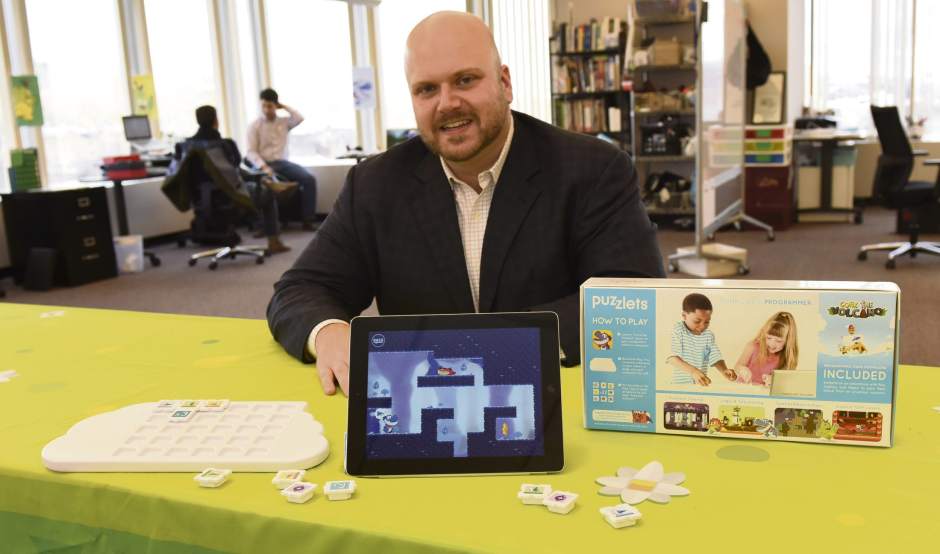North Side toymaker Digital Dream Labs starts strong in 1st holiday season
Holiday sales are critical for toy companies, and Jacob Hanchar hopes this shopping season will put his startup on a path to long-term success.
Hanchar, 36, is CEO of Digital Dream Labs, a North Side-based company that makes a toy called Puzzlets. It's an educational game system that consists of an electronic tray and tiles that connect via Bluetooth to mobile devices.
Puzzlets hit the market in September and is being sold online and in stores, including Amazon and Toys ‘R' Us. Hanchar talked about what it's like to bring a toy to market and distinguish it from competitors. An edited transcript follows.
Trib: What are your expectations for your first holiday season on the market?
Hanchar: Our goal was to sell 4,000 units, and we've reached that goal. We're now thinking that if we sell 5,000 units, we will not need to fund-raise probably until sometime next year.
Trib: Were you hoping to use the holiday sales as a launching pad for Digital Dream Labs?
Hanchar: Yes, absolutely. September, believe it or not, is usually when holiday season items get put on the shelf or when they launch. Granted, most people aren't even paying attention yet, but that's how retailers gear up.
Trib: I would imagine you would want to have everything set up for this launch. If something doesn't work, it can be disastrous for companies that are still establishing their brand with customers.
Hanchar: There's no room for error. Everything has to be as close to perfect as possible. One of our competitors went to a cheap Chinese factory, got the lowest bid, and the product didn't fit together and it almost bankrupted the company. We don't have the luxury of making mistakes like that.
Trib: How have you tried to distinguish your products?
Hanchar: We've had this go into school districts. Fox Chapel School District has it. And we're doing a very large study at Avonworth this fall, to do a follow-up study for something that we were very surprised at: It turns out Puzzlets improves reading comprehension. That, to me, is going to set us apart — that we have this legitimate educational product that happens to have toy-like qualities.
Trib: How do you make that case on a website like Amazon.com, where there's so much stuff?
Hanchar: You do that one step at a time. Popular Mechanics — we won toy of the year. We're getting additional accolades. Good Housekeeping will be announcing we're one of their top tech toys. And we're going to find other places to raise awareness. It's just a matter of meeting lots of people and showing them the product and them naturally just liking it.
Trib: What have you found are the biggest challenges of trying to sell this online?
Hanchar: When the Wall Street Journal article came out on us, we had a lot of people not even go to our website. They went straight to Amazon, did a bunch of research on Amazon and purchased on Amazon when they could have purchased it on our website for less. We have a lot of people with an Amazon shopping cart that is filled with our product — they just haven't checked out. We know lots of people are about to purchase this and are waiting for the holidays to come. You're wondering, is it just because the holidays haven't come up? Are we not marketing this well enough? Are we not getting the value proposition out there? Are we not articulating it? We're constantly changing. We're changing our messaging, what we're talking about with our website.
Trib: What's a change that you've made recently?
Hanchar: Peter Kinney — he's one of the founders — saw that people were taking a long time going through our shopping experience. That there were four or five Web pages that you click through before you complete the purchase. So we're going to halve it to two pages. That's just one example of us trying to adapt and make life easier for the consumer.
Trib: Since you're sold both online and in stores, which channel have you found works better?
Hanchar: What we're discovering with Toys ‘R' Us is it's a great brand to be associated with. It also provides an opportunity for us to stand next to the product and demonstrate it. We can personally go to these stores and demonstrate it. It provides all of these opportunities to get in front of the child; the parent can see our value proposition. That's absolutely essential.
Trib: Long term, what do you see being the balance in sales online versus brick and mortar?
Hanchar: I think, long term, online is the future of sales. I think we'll have 60 percent of sales online and 40 percent in brick and mortar. But that's not 100 percent. If we do well at Toys ‘R' Us, we'll be given even more stores next year. If Costco sees those numbers and we do well with Toys R Us, then they'll take us on as well. And then we'll be sold through Costco. So those will be our two main brick and mortar places that we would start with Q1 2016. That's really where we would head.
Chris Fleisher is a staff writer for Trib Total Media. He can be reached at 412-320-7854 or cfleisher@tribweb.com.

